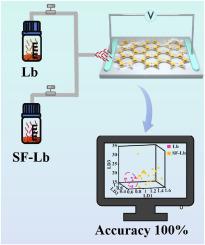基于挥发组学的cof薄膜化学电阻器枸杞品质鉴别
IF 10.3
4区 化学
Q1 CHEMISTRY, INORGANIC & NUCLEAR
引用次数: 0
摘要
硫熏蒸过程不仅会诱导枸杞(Lycium barbarum,一种广泛使用的中药)的化学转化,而且严重影响人体健康。鉴于目前硫烟枸杞(SF-Lb)检测方法存在操作复杂、耗时长、技术要求高等挑战,本文采用简单的化学电阻器对具有显著挥发组学差异的Lb和SF-Lb进行鉴别研究。该传感器由导电金属有机骨架(cMOF)薄膜Cu3(HHTP)2构成,由于其丰富的活性位点,优异的电子转移性能以及检测特定组的挥发性有机化合物(VOCs)的能力。因此,基于Cu3(HHTP)2的传感器对0.5 g SF-Lb(151.74%)的响应值明显高于对正常Lb(80.07%)的响应值,可以简单快速地识别SF-Lb,准确度为100%。本研究对硫熏中草药的挥发组学进行了研究,建立了一种新的硫熏中草药快速鉴别方法。本文章由计算机程序翻译,如有差异,请以英文原文为准。

Volatolomics-based quality identification of Lycium barbarum using cMOF thin film chemiresistors
The sulfur-fumigation process not only induces the chemical transformation of Lycium barbarum (Lb, a widely used traditional Chinese medicine) but also severely influences human health. Given the existing challenges like the complex and time-consuming operation, as well as the high technical demands of the current detection methods for sulfur-fumed Lycium barbarum (SF-Lb), this paper employs a simple chemiresistor to carry out discrimination research between Lb and SF-Lb which have significant differences in volatolomics. The sensor is constructed by a conductive metal-organic framework (cMOF) thin film, Cu3(HHTP)2, due to its abundant active sites, excellent electron transfer performance as well as the capacity to detect specific groups of volatile organic compounds (VOCs). Consequently, the response values of Cu3(HHTP)2-based sensor to 0.5 g SF-Lb (151.74%) are significantly higher than those to normal Lb (80.07%), identifying SF-Lb simply and rapidly with an accuracy of ∼100%. Our work investigates volatolomics of SF-Lb and establishes a new rapid discrimination method for sulfur-fumed traditional Chinese herbs.
求助全文
通过发布文献求助,成功后即可免费获取论文全文。
去求助
来源期刊

结构化学
化学-晶体学
CiteScore
4.70
自引率
22.70%
发文量
5334
审稿时长
13 days
期刊介绍:
Chinese Journal of Structural Chemistry “JIEGOU HUAXUE ”, an academic journal consisting of reviews, articles, communications and notes, provides a forum for the reporting and discussion of current novel research achievements in the fields of structural chemistry, crystallography, spectroscopy, quantum chemistry, pharmaceutical chemistry, biochemistry, material science, etc. Structural Chemistry has been indexed by SCI, CA, and some other prestigious publications.
 求助内容:
求助内容: 应助结果提醒方式:
应助结果提醒方式:


